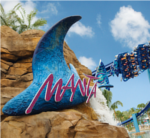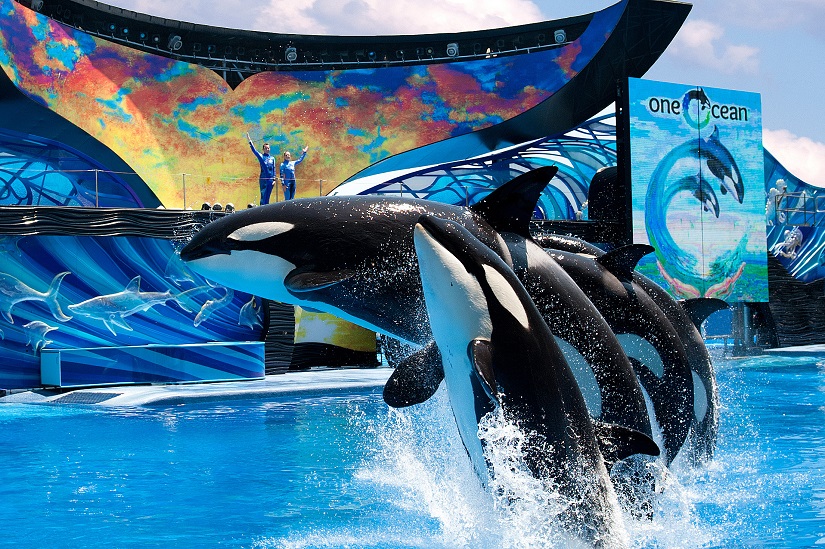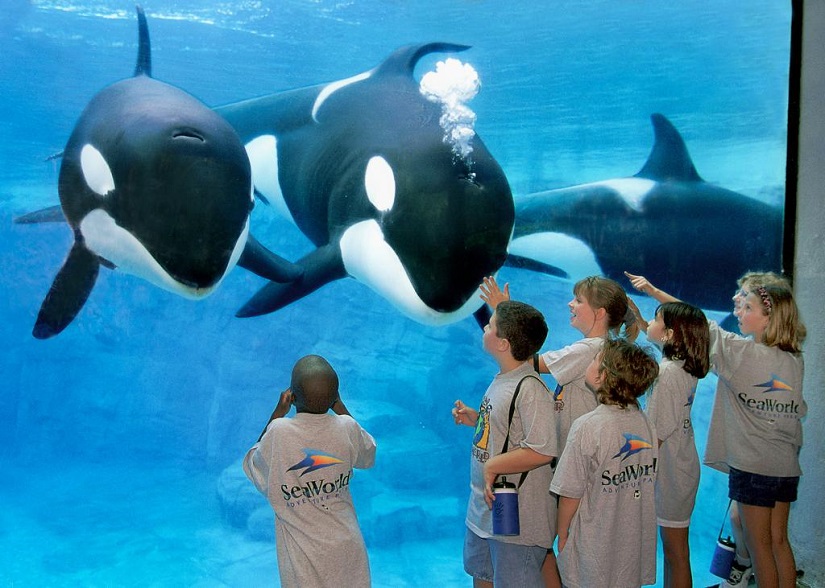SeaWorld Entertainment Reports First Quarter 2017 Results

SeaWorld Entertainment, Inc., a leading theme park and entertainment company that owns and operates twelve theme parks, today reported its financial results for the first quarter of this year. "Given the improving attendance trends we saw in April, and the incredibly robust lineup of new attractions we are launching in the coming weeks, we are well-positioned going into our seasonally important 2nd and 3rd quarters" stated Joel Manby, President and Chief Executive Officer of SeaWorld Entertainment, Inc.
"Our season pass sales revenues for 2017 are up nearly 6%; the cost optimization program we initiated in the fourth quarter of 2016 continues to have a positive impact on results; and the successful renewal and increased capacity of our revolving credit facility and refinancing of our existing term debt in late March of 2017 enhances our financial flexibility."
"Our strategy and progress received a strong vote of confidence with the acquisition by Zhonghong Zhuoye Group of Blackstone's approximately 21% stake in the company at a significant premium to our current market price per share. Additionally, the advisory and support agreements we entered into in late March of 2017 with Zhonghong Holding give us the opportunity to carefully evaluate new strategic growth opportunities in China, Taiwan, Hong Kong and Macau."

"Our Board and management are intently focused on increasing value for our shareholders. Looking ahead, our revenue management and cost optimization initiatives, as well as one of the strongest lineups of new attractions we've ever offered, give us confidence that we will achieve improved performance in all elements of our five-point plan," Manby continued. "We expect to drive attendance through the continued introduction of fun and meaningful experiences for our guests, and will work to improve ticket yields through increased use of new strategic and tactical pricing initiatives. We're very excited about 2017, and look forward to reporting our progress throughout the year."
Overview
- Total revenues were $186.4 million, compared to $220.2 million in the first quarter of 2016, primarily due to a shift in the timing of the Easter holiday into the second quarter of 2017.
- Year-to-date attendance through the end of April is essentially flat over the prior year period.
- Exciting lineup of new attractions coming online in the second quarter.
- Season pass sales revenue up nearly 6% through the end of April compared to the same period of 2016.
- The company remains on pace to achieve its cost optimization program net cost savings targets.
- For the full year of 2017, the company expects Adjusted EBITDA[1] in the range of $330-$360 million.
First Quarter 2017 Results
Results for the first quarter of 2017 were largely impacted by a shift in the timing of spring break holidays associated with Easter moving into the second quarter of 2017. During the first quarter of 2017, the company generated total revenues of $186.4 million, a decrease of $33.9 million, or 15%, compared to the first quarter of 2016. The company generated a net loss of $61.1 million, or a loss of $0.72 per diluted share compared to a net loss of $84.0 million, or a loss of $1.00 per diluted share, in the first quarter of 2016.
Adjusted EBITDA was a loss of $30.4 million in the first quarter of 2017 compared to an Adjusted EBITDA loss of $5.9 million in the first quarter of 2016. Net cash provided by operating activities was $5.7 million and $32.2 million in the first three months of 2017 and 2016, respectively.

Attendance for the first quarter of 2017 declined by approximately 491,000 guests, or 14.9%, compared to the first quarter of 2016, primarily due to a shift in the timing of the Easter holiday into the second quarter of 2017, which also impacted the timing of spring break for a number of schools in the company's key source markets. Attendance was also impacted, to a lesser extent, by a decline at the company's SeaWorld San Diego park where construction of the new Orca Encounter commenced in January for a planned opening this summer.
The company believes the decline in attendance during this transition results largely from a lack of new content during the interim period. Latin America attendance for the first quarter of 2017 declined by approximately 24,000 guests compared to the first quarter of 2016. On a year-to-date basis through the end of April, attendance was essentially flat over the prior year period and season pass sales revenues were up nearly 6% compared to the same period of 2016.
The company believes the decline in attendance during this transition results largely from a lack of new content during the interim period. Latin America attendance for the first quarter of 2017 declined by approximately 24,000 guests compared to the first quarter of 2016. On a year-to-date basis through the end of April, attendance was essentially flat over the prior year period and season pass sales revenues were up nearly 6% compared to the same period of 2016.
Total revenue per capita (total revenue divided by attendance) decreased by 0.6% to $66.41 in the first quarter of 2017 compared to $66.80 in the prior year first quarter, primarily due to a decline in admission per capita (admissions revenue divided by attendance) partially offset by an increase in in-park per capita spending (food, merchandise and other revenue divided by attendance).
Admission per capita decreased by 1.2% to $41.01 in the first quarter of 2017 from $41.53 in the prior year first quarter, primarily due to the unfavorable timing of Easter which caused some of the company's international and domestic attendance to shift from the first quarter to the second quarter of 2017. Admission per capita also declined due to an unfavorable ticket mix driven by increased utilization of season pass products and associated free promotional ticket offerings when compared to the first quarter of 2016. In-park per capita spending increased slightly by 0.5% to $25.40 in the first quarter of 2017, from $25.27 in the prior year first quarter.
Admission per capita decreased by 1.2% to $41.01 in the first quarter of 2017 from $41.53 in the prior year first quarter, primarily due to the unfavorable timing of Easter which caused some of the company's international and domestic attendance to shift from the first quarter to the second quarter of 2017. Admission per capita also declined due to an unfavorable ticket mix driven by increased utilization of season pass products and associated free promotional ticket offerings when compared to the first quarter of 2016. In-park per capita spending increased slightly by 0.5% to $25.40 in the first quarter of 2017, from $25.27 in the prior year first quarter.
Operating expenses for the first quarter of 2017 decreased $23.0 million, or approximately 13%, to $157.3 million as compared to $180.3 million in the first quarter of 2016. The decrease primarily relates to a decline in equity compensation expense and a decrease in asset write-offs when compared to the first quarter of 2016. The first quarter of 2016 included incremental equity compensation expense of $9.0 million associated with certain performance vesting restricted shares which vested on April 1, 2016 and $6.4 million in asset write-offs associated with the canceled Blue World Project.
Operating expenses also decreased due to cost savings initiatives which included a reduction in headcount in December 2016 along with a decrease in direct labor costs driven by the decline in volume for the quarter. Selling, general and administrative expenses for the first quarter of 2017 decreased $14.9 million, or approximately 22%, to $52.4 million as compared to $67.4 million in the first quarter of 2016. The decrease primarily relates to a decline in equity compensation expense which was partially offset by an increase in marketing costs due to the timing of advertising promotions versus the prior year period. The first quarter of 2016 included incremental equity compensation expense of $18.5 million associated with certain performance vesting restricted shares which vested on April 1, 2016.
Operating expenses also decreased due to cost savings initiatives which included a reduction in headcount in December 2016 along with a decrease in direct labor costs driven by the decline in volume for the quarter. Selling, general and administrative expenses for the first quarter of 2017 decreased $14.9 million, or approximately 22%, to $52.4 million as compared to $67.4 million in the first quarter of 2016. The decrease primarily relates to a decline in equity compensation expense which was partially offset by an increase in marketing costs due to the timing of advertising promotions versus the prior year period. The first quarter of 2016 included incremental equity compensation expense of $18.5 million associated with certain performance vesting restricted shares which vested on April 1, 2016.

The company remains on pace to achieve its targets for its previously announced cost optimization program which is expected to result in $40.0 million in net savings by the end of 2018.
PHOTOS: © 2017 SeaWorld Parks & Entertainment, Inc. All Rights Reserved.


Post a Comment